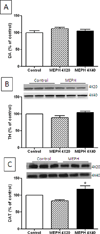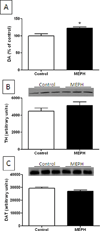Mephedrone, an abused psychoactive component of 'bath salts' and methamphetamine congener, does not cause neurotoxicity to dopamine nerve endings of the striatum
- PMID: 22191803
- PMCID: PMC3296829
- DOI: 10.1111/j.1471-4159.2011.07632.x
Mephedrone, an abused psychoactive component of 'bath salts' and methamphetamine congener, does not cause neurotoxicity to dopamine nerve endings of the striatum
Abstract
Mephedrone (4-methylmethcathinone) is a β-ketoamphetamine with close structural analogy to substituted amphetamines and cathinone derivatives. Abuse of mephedrone has increased dramatically in recent years and has become a significant public health problem in the United States and Europe. Unfortunately, very little information is available on the pharmacological and neurochemical actions of mephedrone. In light of the proven abuse potential of mephedrone and considering its similarity to methamphetamine and methcathinone, it is particularly important to know if mephedrone shares with these agents an ability to cause damage to dopamine nerve endings of the striatum. Accordingly, we treated mice with a binge-like regimen of mephedrone (4 × 20 or 40 mg/kg) and examined the striatum for evidence of neurotoxicity 2 or 7 days after treatment. While mephedrone caused hyperthermia and locomotor stimulation, it did not lower striatal levels of dopamine, tyrosine hydroxylase or the dopamine transporter under any of the treatment conditions used presently. Furthermore, mephedrone did not cause microglial activation in striatum nor did it increase glial fibrillary acidic protein levels. Taken together, these surprising results suggest that mephedrone, despite its numerous mechanistic overlaps with methamphetamine and the cathinone derivatives, does not cause neurotoxicity to dopamine nerve endings of the striatum.
© 2011 The Authors. Journal of Neurochemistry © 2011 International Society for Neurochemistry.
Conflict of interest statement
The authors declare that they have no conflict of interest related to the publication of this article.
Figures





 ) whereas those that do not differ are closed red symbols (
) whereas those that do not differ are closed red symbols ( ).
).
References
-
- Albers DS, Sonsalla PK. Methamphetamine-induced hyperthermia and dopaminergic neurotoxicity in mice: pharmacological profile of protective and nonprotective agents. J. Pharmacol. Exp. Ther. 1995;275:1104–1114. - PubMed
-
- Banjaw MY, Schmidt WJ. Behavioural sensitisation following repeated intermittent oral administration of Catha edulis in rats. Behav. Brain Res. 2005;156:181–189. - PubMed
-
- Banjaw MY, Schmidt WJ. Catha edulis extract and its active principle cathinone induce ipsilateral rotation in unilaterally lesioned rats. Behav. Pharmacol. 2006;17:615–620. - PubMed
-
- Bowyer JF, Davies DL, Schmued L, Broening HW, Newport GD, Slikker W, Jr, Holson RR. Further studies of the role of hyperthermia in methamphetamine neurotoxicity. J. Pharmacol. Exp. Ther. 1994;268:1571–1580. - PubMed
-
- Brown JM, Quinton MS, Yamamoto BK. Methamphetamine-induced inhibition of mitochondrial complex II: roles of glutamate and peroxynitrite. J. Neurochem. 2005;95:429–436. - PubMed
Publication types
MeSH terms
Substances
Grants and funding
LinkOut - more resources
Full Text Sources
Medical

